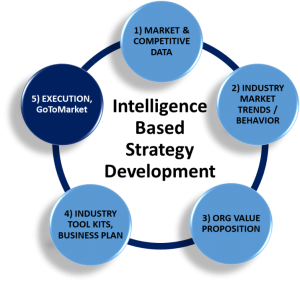 By Paul Santilli
By Paul SantilliWorldwide OEM Industry Intelligence and Strategy
Hewlett Packard Enterprise
Part one of my series, Introduction to Intelligence-Driven Demand, outlined three key states of organizational reaction to disruption, and their relevance to effectively leveraging data for competitive intelligence and strategic planning. Part two will focus on execution and extracting value from the large volume of data available to organizations today.
So how does one execute on the value they’ve extracted from all of the data analytics and assessments in this highly dynamic environment? There are a few fundamental areas of the demand-generation roadmap that organizations traditionally use. I’ve highlighted them in Figure 1 below, but modified them based on intelligence-driven signals that would warrant a different set of actions around implementation and execution – below I will talk about the light-blue components only:
FIGURE 1: INTELLIGENCE DRIVEN GTM ROADMAP

1) Identify Specific Growth Enabling Opportunities through Competitive and Market Assessments
It is imperative that the scope of the effort is clearly defined from the onset. The ultimate goal, of course is to grow revenue, but you’ll need to determine whether that will come from organic growth opportunities, competitive reallocation of sales, specific to a geography or along a specific product or service offering, or something else? Is it within a specific vertical market application? The easy approach is to say “all of the above” – but that could be extremely daunting given the scale of the investigation and the resultant actions that might be required to execute to such a large-scale spectrum. Rather, I’ve practiced a somewhat phased approach to this by initially generating a high-level overview of opportunity based on the gap/overlap of the existing business model, then used this to highlight large potential target opportunities to do deep-dives to extract the most efficient and highest ROI from the effort. And often there is some “low-hanging fruit” from such a targeted, high-opportunity approach that can yield great results in a short period of time. Then, as your processes and methodologies improve, you can stretch farther “up the tree” to extract those opportunities that require more effort and are harder to identify. This multi-phased approach builds upon your previous experience (and successes!) and allows you to further mature intelligence modeling over time.
Internally Investigate the Market
With this target environment carefully identified, the first natural approach is to have an internal assessment performed by your company intelligence team to investigate public domain (secondary research) content and determine assessments and opportunities. Unfortunately, if you utilized ALL sources of public domain content, including OSINT, HUMINT, SoMe and all other paid and un-paid sources, this data size can be overwhelming. This is where it is an absolute MUST to employ various data / knowledge management tools that incorporate AI into their algorithms to collect, process and analyze the vast amount of data, but to also become more efficient in generating the required content over time, and hopefully, auto-generate reports, sales enablement tools, and related content that provides a prescriptive mechanism towards strategy positioning. It is important to note that because of the very nature our industry and society and the speed of data generation associated with a 4th industrial revolution environment, these tools are necessary to allow us to keep an almost a real-time pulse of the business environment. The old methods of looking at historical “batch-based” data events that we take a snapshot of and use for all of our forward-thinking strategic analysis is now woefully inadequate and uncompetitive.
Externally Investigate the Market
A further critical component of intelligence modeling, especially when you are looking to “deep-dive” into more specific areas of opportunities, is to utilize unbiased 3rd party solution providers. You’ll want to employ them for subsequent additional content around secondary research perspectives, and moreover to use their talents to acquire critical primary research information from users and market influencers. Information around macro trends, industry workloads, customer sentiments, and related product and technology shifts, especially around digital transformation, will greatly help in understanding market dynamics and charting the appropriate course for the company.
Additionally, especially in a B2B environment, utilizing information from channel partners, alliances, vendor sourcing relationships, events, trade shows, and many other data-rich environments can yield perspectives not only on industry and product direction, but also on competitive comparisons and performance, product and service offerings, and investment areas for growth.
2) Market Trends, Workloads
Some organizations will defer performing this exercise, but I believe this is something that is increasingly important to do given the very nature of the perpetual disruptive environment we are in. Having a constant picture of what the ongoing market trends and industry workloads associated with your product / service offering is, is necessary to better understand overall maturation and hyper-curve analyses for your industry. This includes customer sentiments and transitional preferences based on changing norms, and the advent of new technology and competitive offerings and positioning.
3) Company Portfolio Assessment
Comparing these industry shifts and transitory pivot points is helpful when trying to determine your company’s product and service offering roadmap, and to ensure that they are not only aligned to industry and consumer/market trends, but are optimally in front of the demand. This allows you to be more of a capability and solution trailblazer, rather than one of the dozens that are playing “catch-up” to the solution pioneers that are already leading the way.
4) Industry Toolkits and Business Plan
At this juncture, we should have the necessary information on opportunities to pursue for best ROI and business growth. Now we have to target sales enablement and a GTM strategy that allows for awareness of activities and offerings, but also includes a focus on lead generation and areas to exploit the competitive advantage your company offers in this space. An effective GTM strategy consists of combining both internal and external sales organizations (channel, distributor, etc.) to effectively deliver your company’s value proposition to your customers and outperform competitive offerings. Equipping your sales force with the necessary training, tools and knowledge to best outfit them with the ability to out maneuver the competition and offer a better solution set around your portfolio offering than the competition is necessary. This not only includes a marketing plan, but also product introduction and related strategies to fully exploit the window of opportunity around consumer needs and market acceptance.
Marketing, Communications and Evangelism
Additionally, creating campaigns around different marketing program mechanisms is a required investment for successful business growth. Depending on the industry, product, services, and geography, different marketing platforms can be used. This would include but certainly not be limited to, social network and SoMe marketing, paid media, e-mail and direct, account based, co-branding / channel partner relationship marketing, etc. And, as part of the marketing effort, a clear and comprehensive evangelism program needs to be put in place to not only heighten brand and product awareness and the company value proposition, but to also offer customer testimonials, showcasing user experiences, and validating business-solving applications for your customer base. These efforts can be drawn from opportunities that are cited from within the intelligence analyses on how and where to best focus investments and resources to achieve an optimal marketing and evangelism model that maximizes growth opportunities.
Substantiate via User Community
This is an important component of your overall business life cycle that I believe often gets overlooked, or at a minimum, under emphasized. Of course, sales and related metrics can always tell you consumer acceptance and success of your business offerings. But gathering customer insight, both informally and formally, is a critical component of understanding the elements of your strategy that worked or didn’t work, and how to best correct them for next time. This is really a determination around a return on investment (ROI) that can then provide you intelligence on where to (re)invest or where to not invest and change course based on business conditions and/or competitive / consumer profiles.
But alas, we are not quite done yet. The success of this overall approach is only as good as the execution and implementation thoroughness. That is what we will be showcasing in the next and final blog that will be coming out shortly.
Paul Santilli currently leads the HPE Worldwide (WW) Industry Intelligence & Strategy Organization for the Original Equipment Manufacturer (OEM) Solutions Business for Hewlett Packard Enterprise (HPE). He is a recognized thought leader in Data Analytics Modeling around Industry Intelligence, Insights and Strategy, and chairs Executive Customer Councils and Industry Advisory Boards globally.
Paul also serves as Chairman Emeritus of the Strategic Competitive Intelligence Professionals (SCIP) Board of Directors Executive Committee and is active in several advisory roles to industry conferences and forums. Paul presents worldwide on Intelligence, Innovation, and Strategy in keynote and executive coaching capacities, and has published numerous papers in industry and academic journals related to Intelligence Modeling, Innovation, Disruption, and Strategy. Paul is also Founder and CEO of Strategence LLC, a company that provides proprietary advisory and business insights & analytics to companies for intelligence-based business growth.



Recent Comments